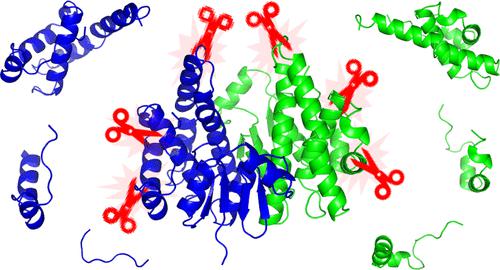当前位置:
X-MOL 学术
›
J. Am. Chem. Soc.
›
论文详情
Our official English website, www.x-mol.net, welcomes your feedback! (Note: you will need to create a separate account there.)
Native Top-Down Mass Spectrometry with Collisionally Activated Dissociation Yields Higher-Order Structure Information for Protein Complexes
Journal of the American Chemical Society ( IF 15.0 ) Pub Date : 2022-11-28 , DOI: 10.1021/jacs.2c06726 Carter Lantz 1 , Benqian Wei 1 , Boyu Zhao 1 , Wonhyeuk Jung 1 , Andrew K Goring 1 , Jessie Le 1 , Justin Miller 2 , Rachel R Ogorzalek Loo 1, 2, 3 , Joseph A Loo 1, 2, 3, 4
Journal of the American Chemical Society ( IF 15.0 ) Pub Date : 2022-11-28 , DOI: 10.1021/jacs.2c06726 Carter Lantz 1 , Benqian Wei 1 , Boyu Zhao 1 , Wonhyeuk Jung 1 , Andrew K Goring 1 , Jessie Le 1 , Justin Miller 2 , Rachel R Ogorzalek Loo 1, 2, 3 , Joseph A Loo 1, 2, 3, 4
Affiliation

|
Native mass spectrometry (MS) of proteins and protein assemblies reveals size and binding stoichiometry, but elucidating structures to understand their function is more challenging. Native top-down MS (nTDMS), i.e., fragmentation of the gas-phase protein, is conventionally used to derive sequence information, locate post-translational modifications (PTMs), and pinpoint ligand binding sites. nTDMS also endeavors to dissociate covalent bonds in a conformation-sensitive manner, such that information about higher-order structure can be inferred from the fragmentation pattern. However, the activation/dissociation method used can greatly affect the resulting information on protein higher-order structure. Methods such as electron capture/transfer dissociation (ECD and ETD, or ExD) and ultraviolet photodissociation (UVPD) can produce product ions that are sensitive to structural features of protein complexes. For multi-subunit complexes, a long-held belief is that collisionally activated dissociation (CAD) induces unfolding and release of a subunit, and thus is not useful for higher-order structure characterization. Here we show not only that sequence information can be obtained directly from CAD of native protein complexes but that the fragmentation pattern can deliver higher-order structural information about their gas- and solution-phase structures. Moreover, CAD-generated internal fragments (i.e., fragments containing neither N-/C-termini) reveal structural aspects of protein complexes.
中文翻译:

具有碰撞激活解离的本机自上而下质谱法产生蛋白质复合物的高阶结构信息
蛋白质和蛋白质组装体的天然质谱 (MS) 揭示了大小和结合化学计量,但阐明结构以了解它们的功能更具挑战性。本机自上而下 MS (nTDMS),即气相蛋白的片段化,通常用于获取序列信息、定位翻译后修饰 (PTM) 和查明配体结合位点。nTDMS 还努力以构象敏感的方式解离共价键,以便可以从碎片模式中推断出有关高阶结构的信息。然而,所使用的激活/解离方法会极大地影响蛋白质高级结构的结果信息。电子捕获/转移解离(ECD 和 ETD,或 ExD) 和紫外光解离 (UVPD) 可以产生对蛋白质复合物的结构特征敏感的产物离子。对于多亚基复合物,长期以来人们认为碰撞激活解离 (CAD) 会诱导亚基的展开和释放,因此对高阶结构表征没有用处。在这里,我们不仅展示了序列信息可以直接从天然蛋白质复合物的 CAD 中获得,而且碎片模式可以提供有关其气相和溶液相结构的高阶结构信息。此外,CAD 生成的内部片段(即不包含 N-/C-末端的片段)揭示了蛋白质复合物的结构方面。长期以来,人们一直认为碰撞激活解离 (CAD) 会诱导亚基的展开和释放,因此对高阶结构表征没有用处。在这里,我们不仅展示了序列信息可以直接从天然蛋白质复合物的 CAD 中获得,而且碎片模式可以提供有关其气相和溶液相结构的高阶结构信息。此外,CAD 生成的内部片段(即不包含 N-/C-末端的片段)揭示了蛋白质复合物的结构方面。长期以来,人们一直认为碰撞激活解离 (CAD) 会诱导亚基的展开和释放,因此对高阶结构表征没有用处。在这里,我们不仅展示了序列信息可以直接从天然蛋白质复合物的 CAD 中获得,而且碎片模式可以提供有关其气相和溶液相结构的高阶结构信息。此外,CAD 生成的内部片段(即不包含 N-/C-末端的片段)揭示了蛋白质复合物的结构方面。在这里,我们不仅展示了序列信息可以直接从天然蛋白质复合物的 CAD 中获得,而且碎片模式可以提供有关其气相和溶液相结构的高阶结构信息。此外,CAD 生成的内部片段(即不包含 N-/C-末端的片段)揭示了蛋白质复合物的结构方面。在这里,我们不仅展示了序列信息可以直接从天然蛋白质复合物的 CAD 中获得,而且碎片模式可以提供有关其气相和溶液相结构的高阶结构信息。此外,CAD 生成的内部片段(即不包含 N-/C-末端的片段)揭示了蛋白质复合物的结构方面。
更新日期:2022-11-28
中文翻译:

具有碰撞激活解离的本机自上而下质谱法产生蛋白质复合物的高阶结构信息
蛋白质和蛋白质组装体的天然质谱 (MS) 揭示了大小和结合化学计量,但阐明结构以了解它们的功能更具挑战性。本机自上而下 MS (nTDMS),即气相蛋白的片段化,通常用于获取序列信息、定位翻译后修饰 (PTM) 和查明配体结合位点。nTDMS 还努力以构象敏感的方式解离共价键,以便可以从碎片模式中推断出有关高阶结构的信息。然而,所使用的激活/解离方法会极大地影响蛋白质高级结构的结果信息。电子捕获/转移解离(ECD 和 ETD,或 ExD) 和紫外光解离 (UVPD) 可以产生对蛋白质复合物的结构特征敏感的产物离子。对于多亚基复合物,长期以来人们认为碰撞激活解离 (CAD) 会诱导亚基的展开和释放,因此对高阶结构表征没有用处。在这里,我们不仅展示了序列信息可以直接从天然蛋白质复合物的 CAD 中获得,而且碎片模式可以提供有关其气相和溶液相结构的高阶结构信息。此外,CAD 生成的内部片段(即不包含 N-/C-末端的片段)揭示了蛋白质复合物的结构方面。长期以来,人们一直认为碰撞激活解离 (CAD) 会诱导亚基的展开和释放,因此对高阶结构表征没有用处。在这里,我们不仅展示了序列信息可以直接从天然蛋白质复合物的 CAD 中获得,而且碎片模式可以提供有关其气相和溶液相结构的高阶结构信息。此外,CAD 生成的内部片段(即不包含 N-/C-末端的片段)揭示了蛋白质复合物的结构方面。长期以来,人们一直认为碰撞激活解离 (CAD) 会诱导亚基的展开和释放,因此对高阶结构表征没有用处。在这里,我们不仅展示了序列信息可以直接从天然蛋白质复合物的 CAD 中获得,而且碎片模式可以提供有关其气相和溶液相结构的高阶结构信息。此外,CAD 生成的内部片段(即不包含 N-/C-末端的片段)揭示了蛋白质复合物的结构方面。在这里,我们不仅展示了序列信息可以直接从天然蛋白质复合物的 CAD 中获得,而且碎片模式可以提供有关其气相和溶液相结构的高阶结构信息。此外,CAD 生成的内部片段(即不包含 N-/C-末端的片段)揭示了蛋白质复合物的结构方面。在这里,我们不仅展示了序列信息可以直接从天然蛋白质复合物的 CAD 中获得,而且碎片模式可以提供有关其气相和溶液相结构的高阶结构信息。此外,CAD 生成的内部片段(即不包含 N-/C-末端的片段)揭示了蛋白质复合物的结构方面。


























 京公网安备 11010802027423号
京公网安备 11010802027423号